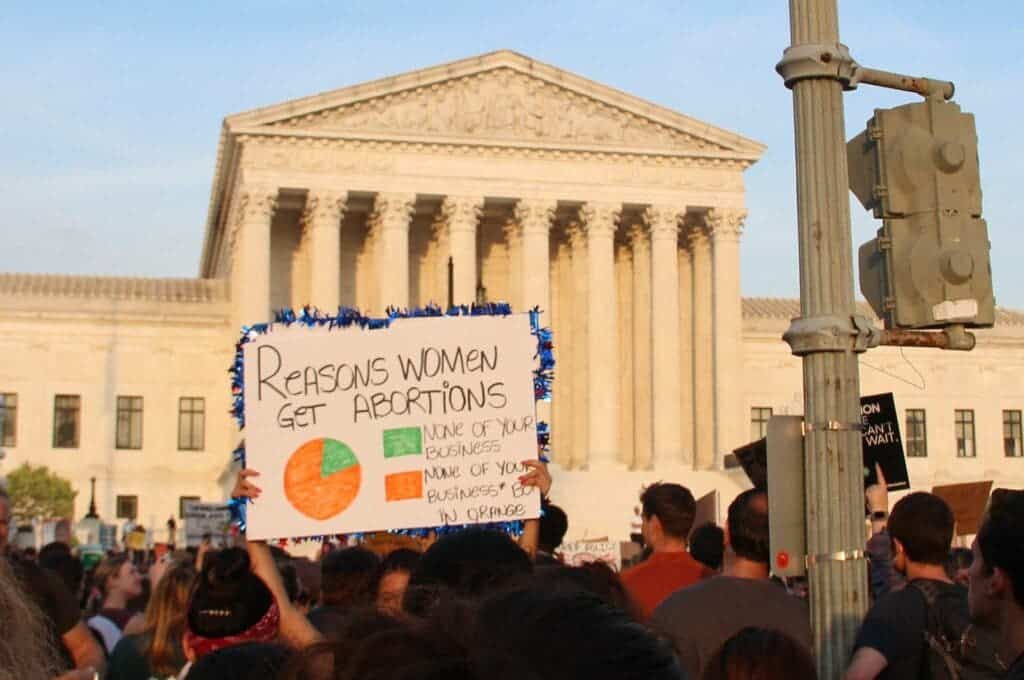Abortion was banned in multiple US states just hours after the Supreme Court of the US overturned the landmark Roe v Wade decision. More than 50 years after the decision was established, Roe v Wade was overturned, leaving it up to individual states to decide whether abortions were legal or not. Several states have already banned it, and it’s expected that around half of all US states will eventually do the same.
The decision sent ripples not just across the US, but also throughout the world. Women’s hard-earned rights were wiped away in one fell swoop, although just a third of Americas actually wanted the decision to be overturned — Americans still want access to abortion, with restrictions. It is perhaps telling that former US President Donald Trump promised to appoint Supreme Court justices who would reverse Roe, and succeeded in replacing three justices during his presidency. There are now six conservative justices on the court, and six votes against Roe.
The decision doesn’t just go against what the public wants, it also goes against what the science recommends.

Fighting abortion myths
Anti-abortion campaigners regularly assert that abortions are bad for women. In particular, one myth that always seems to pop up is that of PAS — or post-abortion syndrome. The term was coined by Dr. Vincent Rue, a prominent anti-abortion campaigner. Rue claims that he has seem post-traumatic stress disorder in many women who have undergone abortions (though one of his testimonies in 1992 was thrown out by a district judge for “not being credible”).
Researchers have been looking for PAS for years and found no real sign of it. Expert medical bodies don’t include it (it doesn’t appear in the DSM-V handbook of mental health, and is dismissed by organizations such the American Psychological Association and the Royal College of Obstetricians and Gynaecologists). A 2011 study in Denmark that looked at the psychological health of 365,550 women, including 84,620 who’d had abortions, found neither signs of psychological damage nor a higher risk of suicide. A subsequent 2018 study, also from Denmark, found similar things, noting that “policies based on the notion that abortion harms women’s mental health may be misinformed.” In fact, study after study found the same thing.
There have been some 40 reports published in peer-reviewed scientific journals in which researchers analyzed whether abortion causes negative health problems for women — and they found that receiving an abortion did not harm women’s physical and mental health. Lengthy reports published by expert bodies say the same thing. However, being denied abortion (which is often the case even when abortion is legal) resulted in negative health and financial outcomes.
In fact, a landmark study found that the negative effects of being denied an abortion are significant and long-lasting.
Herein lies another myth related to abortion. Abortions, when carried out in a legal and safe environment, pose very little risk. In fact, one study found that abortions are 14 times safer than childbirth, and even 4 times safer than colonoscopies.
But when women are denied abortions, they are more likely to end up in poverty or unemployed or reliant on government assistance. In a post-Roe America, many women will be forced to carry unwanted pregnancies to term — or seek an abortion elsewhere, either in more progressive states or in illegal clinics. Little good can come of this.
What happens when abortion is banned
When people can’t legally have abortions, they don’t just stop having abortions — they look for different ways to have them. Research shows that abortion rates don’t drop significantly when the procedure is outlawed, it simply becomes more dangerous. In fact, a 2012 Lancet study found that regions where access to abortion is restricted have higher rates than more liberal areas. Also, restricted regions had a much higher incidence of unsafe abortion.
Unsafe abortions are still a major problem around the world, but the bulk of the problem is in developing countries. Having half of a developed country like the US join the ranks is a big step backwards. As one researcher puts it, you can’t ban abortion, you can only ban safe abortion.
“According to the World Health Organization, 23,000 women die from unsafe abortions each year and tens of thousands more experience significant health complications globally. A recent study estimated that banning abortion in the U.S. would lead to a 21% increase in the number of pregnancy-related deaths overall and a 33% increase among Black women, simply because staying pregnant is more dangerous than having an abortion. Increased deaths due to unsafe abortions or attempted abortions would be in addition to these estimates,” says Ana Langer, a professor of the practice of public health and coordinator of the Women and Health Initiative at Harvard T.H. Chan School of Public Health.
According to a brief signed by about 550 public-health and reproductive-health researchers and submitted to the Supreme Court, banning abortion may very well increase both maternal and infant mortality rates. When you consider that around one in four women in the United States will have an abortion by age 45, it’s not hard to see how this is a big problem that can spiral further.
Women who are denied abortion are more likely to face a number of social, health, and economic problems.
“Whether one’s stance on abortion access is driven by deeply held views on women’s bodily autonomy or when life begins, the decades of research using rigorous methods is clear: there is a causal link between access to abortion and whether, when, and under what circumstances women become mothers, with ripple effects throughout their lives. Access affects their education, earnings, careers, and the subsequent life outcomes for their children,” write two researchers for The Brookings Institution.
Another brief filed to the Supreme Court by 154 distinguished economists and researchers further emphasized the advantages of Roe.
“For example, recent studies show that the expansion of abortion access ushered in by Roe reduced teen motherhood by 34% and teen marriage by 20%. Studies also demonstrate that for women experiencing unintended pregnancies, access to abortion has increased the probability that they attend college and enter professional occupations,” the researchers write in the brief.
What happens now
Abortion restrictions are harmful and impose economic, social, and health penalties on many pregnant women. The decision of the Supreme Court of the United States could have a devastating impact on women from many US states. While many legal battles will likely start, the problems associated with this decision will be immediate.
Women will be forced to travel to other states where abortion is legal, and some will likely try to end their pregnancies without clinical supervision. Some may be forced to carry unwanted pregnancies to term, which is likely to lead to more teenage mothers and fewer women in higher education. Evidence suggests that the social and economic problems that will cascade from this will be very costly.

The outcome was not a surprise because an initial draft opinion was leaked in May, suggesting that Roe will be overturned. But it is nonetheless disappointing, especially because from a scientific perspective, the decision is hard to justify. If anything, the Supreme Court seemed uninterested in the scientific evidence.
“All I could add at this point is how disappointing it is to see that the majority opinion, like the leaked draft, ignores the fact that there is solid scientific evidence that this decision will harm women,” Caitlin Myers, an economist at Middlebury College in Vermont who has studied the financial impacts of abortion restriction, told Nature.
This falls in line with a number of anti-scientific decisions taken by officials from the US, especially during the coronavirus pandemic — and especially from conservative officials. From governors and presidents ignoring health advice during the pandemic to courts striking down mask and vaccine mandates, we’ve seen plenty of anti-scientific decisions lately. Even so, one would hope that the highest court in the country would respect scientific and medical evidence, but this does not appear to be the case.
In fact, the Supreme Court decision hints that other bodily rights will soon come under fire (like the right to contraception or same-sex marriage). The Supreme Court judges that voted against overturning Roe said this much:
“The right Roe and Casey recognized does not stand alone. To the contrary, the Court has linked it for decades to other settled freedoms involving bodily integrity, familial relationships, and procreation. Most obviously, the right to terminate a pregnancy arose straight out of the right to purchase and use contraception…In turn, those rights led, more recently, to rights of same-sex intimacy and marriage.”
This leaves the US in a precarious situation. Some 85% of Americans believe abortion should be legal in most or all circumstances, but Republicans are widely expected to block abortion rights laws in the Senate, which is evenly split with Democrats. This means any federal abortion law is unlikely to pass soon, even though people want it.
“This decision, read in conjunction with yesterday’s decision on gun control, demonstrates the Court’s (or the conservative majority’s) maddening lack of concern for the real world consequences of their decisions and the real people who will suffer because of them,” Alison Gash, PhD, an associate professor in the Department of Political Science at the University of Oregon, told Healthline.
In the meantime, widespread protests are expected to achieve little if they don’t translate into votes — and even if they do, any change will take time. In the meantime, 26 US states are likely to ban abortion to the fullest extent possible and women (and to a lesser extent, men too) will be left to face the consequences.


